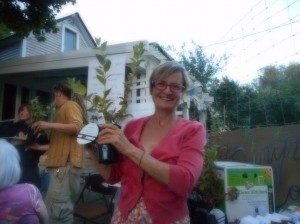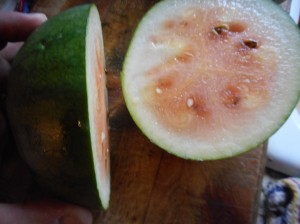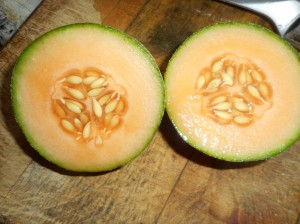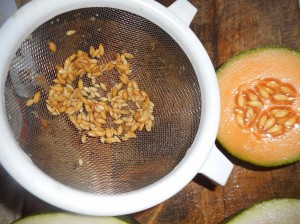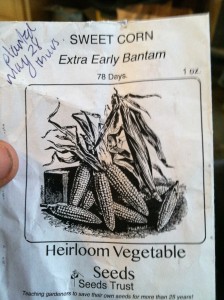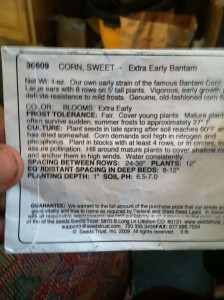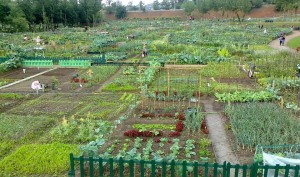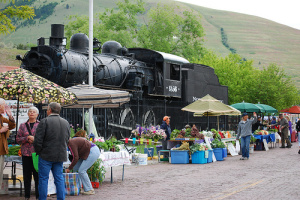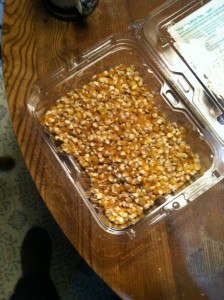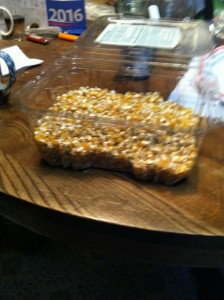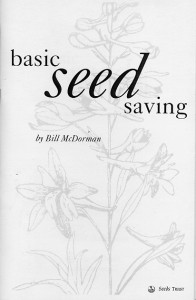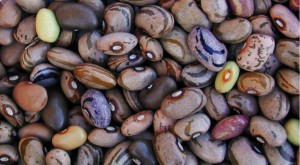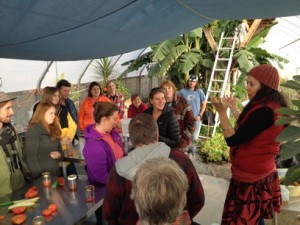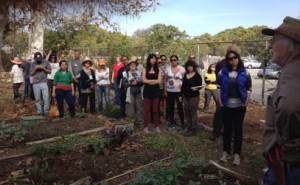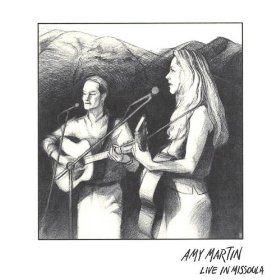100. Bill McDorman | Saving Seeds | Cornville, AZ
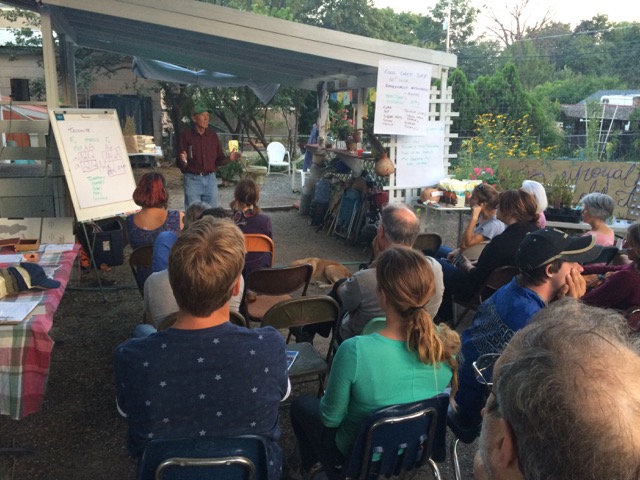
Bill McDorman is Executive Director of Rocky Mountain Seed Alliance, Ketchum, Idaho. He got his start in the bio-regional seed movement while in college in 1979 when he helped start Garden City Seeds in Missoula, Montana. In 1984, Bill started Seeds Trust /High Altitude Gardens, a mail order seed company he ran successfully until it sold to an intern in 2013. He authored the book, Basic Seed Saving, in 1994. In 2010, he and his wife Belle Starr created Seed School, a nationally recognized weeklong training. He served as Executive Director of Native Seeds/SEARCH from 2011 to 2014. Bill is a passionate and knowledgeable presenter who inspires his audiences to learn to save their own seeds.
Well I am super super excited about this interview today because I have been trying to get this extraordinary guest on my show ever since I first heard of him from Robin Kelson from the Good Seed Company back when I first started last March or April!
We grew some of his seeds corn and watermelon and cantaloupes this year very successfully! So he’s here to teach us about saving seeds among other things and maybe even saving our planet!
There’s also an episode about a Seed Saving Workshop at the Penny Royal Collective in Kalispell where I talked about Bill earlier.
FULL SHOW NOTES COMING SOON!
Tell us a little about yourself.
I was a student at the University of Montana bought a little house on the north side of Missoula. For the fist time I was going have my own garden!! I had been brought up growing with my parents. Which I shared but this was gonna be mine. I had Mrs. Sorgie’s old house, famous for her tomatoes. She was one of the original rail road families that staked out the best land in Missoula that you could garden to grow tomatoes
families workers to bring the railroad
had this reputation in the neighborhood to live up to, but I was serious anyway, started looking families around for the seed
that was a thread that changed my life
I’ll ask you how do you find the best seeds for your garden?
What does the best even mean? Is it more then seed porn? By that I mean the catalogs that we look at dreaming about our harvest? Is that the best seeds? Is it because you buy them from the best people? Or many of us are learning, is it be cause you get them from someone local so they are adapted to your area?
I realize that my neighbors, I call him Uncle Vic had talked about all the variety were gone. You just couldn’t find them anymore.
I started digging deeper this was a world wide phenomenon
This was in 1976 that I started researching and we realized that we were gonna lose, all the varieties if we are looking for the best seeds. My gosh that’s a huge problem. If we look now, we lost 96% if you get down to counting which was an article I read in National Geographic a few years ago. I think it was National Geographic May 2011 Issue counted the number of varieties in 1903 vs what’s available right now. And so 96% that’s all the ecological and cultural niches that it took 10,000 years for humans to develop, especially since the start of our country were gone. That’s what really motivated me to look around I was a boy scout.
Let’s find out what’s left.
seemed like a good idea
if we’re really gonna lose this stuff
and make it available again. It was a down home project it’s still there it’s called the MUD project was founded in my bedroom on the North Side of Missoula
I have to tell you the episode 97 released today is with Ellie Costello the current director of MUD.
such great people
organizations that have continued to grow
We started the seed company to make available all the seeds we found it was called Garden City Seeds
ran for 15 years.
ran for western Montana then
John and Karen moved it to the Bitterroot till the non-profit was called
sold it to an entity
Irish eyes
still have the same varieties and descriptions we wrote for their catalog. There’s still a history there so long story short that’s how I got into this.
I had a friend who worked for Garden City Seeds when they were in the Bitterroot!
Tell me about your first gardening experience?
I don’t remember how old, I must have been younger then 6 my parents moved
I remember my father pulling a little carrot out of the ground and it being a magical experience. I couldn’t believe something like that could come out of the ground and it tasted so good and it was like eating candy! I do remember that.
A gentleman who came to our Seed Schools in a church garden a little boy looked at and said
“Gene is that where all carrots come from?” That’s what changed Gene’s life and then he
Life long dedicated to garden education
ended up at one of our Seed Schools.
So when it came time to sign up for Law School.
Let me continue my story of Garden City Seeds
graduating from UM
originally supposed to go to law school
needed to get this non-profit off the ground. I thought in the next 2-3 years of hard work this will be going. After 2-3 years I left, I was burnt out…
wrote the original incorporating papers.
I helped pick the board
bought two lots,
expanded, we planted gardens, we did trials
herb garden… goats and chickens we tried to really live in a self -reliant matter
permaculture came along, as the Penny Royal Collective is trying to do right now, I felt like I walked back into my own backyard
I feel the energy and see what they were experience
Ketchum, ID where I grew up. Ketchum is at 6000 feet bought gardening
growing
I kept track one year and we had 9 frosts and 2 hailstorms between memorial day and labor day
on the edge of people trying to grow food, there were high quality and high conscious people there wanted their own food, the kind you only get when you grow it yourself. I thought growing was a great idea. The world had lost these individually adapted seeds
coops had provided
So I started a seed company called High Altitude Gardens which became Seeds Trust and I ran that for 25 years.
Where I really learned a lot about individual varieties
how to help people
catalog and phones
had to answer a lot of questions over the phone
sitting around talking to people all day
richest experience of my life
hear so many particular problems
from gardeners all over the world
launched me into seed school
teach over 20 years…
probably the high light
I just foiled my original idea
figure out the things that will grow
and get them there
got to go to Siberia in 1989 behind the iron curtain. I got to bring back some treasures. I’m really proud those are still in catalogs and being sold and produced all love the world. It was a wonderful moment for me, they weren’t mine, they were developed by the love and hard work, for the whole period locked behind the iron curtain. I was the first guy from the west who got to walk out of them literally, hidden in my front pockets!
Then didn’t I read something about while you were there you went around and talked to the farmers and learned how they were collecting their seeds?
I was there in august 1989 and the iron curtain came down in November. Neil Young was there rocking and they took the Berlin Wall down, and glasnost and perestroika
I was with the first western group allowed to go to Siberia without the KGB
all gardeners was great wonderful time, lots of tears of hugs everyday, of course sharing lots of seeds, I took a bunch to share, so open hearted that was best to what they had found. That was the background to the whole experience.
Then what happened next? You came back with the seeds, and started the Seeds Trust thing?
Well I grew them and tried them, and if they worked we put them in the catalog. After ten years of doing this people started sending me things! You know gardeners are vain. They would call me or write to me and say “Look I know your pretty proud of winter squash and it’s only 90 days, but mine’s better! Do you want some seeds?”
And I’d say of course and it was hard to keep up with From Mongolia, the mountains of Guatemala. Maybe some of the proudest things I was able to grow and share were from Ken Fisher from Belgrade Montana who had Fisher’s Garden Seeds. His original Mountaineer Squash and Candy Mountain Super Sweet corn and Fisher’s Earliest Corn! They were incredible varieties!
He had hand selected for 50 years or more by the time I had gotten there. He openly shared everything with me. He was a mentor with me. There were all sorts of experiences that paid me. You can imagine trying to run your own small business back then it was hard. There was no internet. I had to borrow money to print catalogs and hope to sell enough to get it back. It was really an interesting time. Once the internet came I didn’t have to deposit checks in the bank, I didn’t have to open letters, and look at orders and type them in and actually it was easier to make a living, so those first 15 years was pretty tough! But I got paid every day! You know knowing I was doing something really important, something really authentic! Something people really appreciate it what I was doing and I think people in 1000 years willl look back and appreciate it. You know in 2 generations we lost 96% or 93% we lost all the varieties. That’s an incredible statistic! We need diversity and all that adaptation to face the storms that are coming! I think in a 1000 years when people look back at us and they’ve grown back all these varieties, they’ll look back at us in the early 21st century and go whoa what happened people? How did you lose all that stuff?! But they’ll look a few people woke up and they got together and they started over growing and saving their own seeds in their own homes and regions and readapted things and creating new diversity! Those were the most important people of the earliest 21st century! Anyone who gets involved in growing and saving their own seeds is doing what I believe is the best and the most important work humans can be doing right now!
This is how we save the planet, it calms people down! It gets them to think long term.starts to feed them where they are. It lowers their carbon footprint. Almost everything we are trying to accomplishment to save what’s left of the nature and diversity and beauty of this planet is enhanced when you come home and grow your own food and save your own seeds and seed saving is the most powerful part of that and will have the most lasting impact.
You can take what you grow in your garden, the best of it, and instead of starting over every year and trying to do that again and again and again!
When you save your own seeds and take the best out of that garden and take it into the next year and the next year! And those of us who have done that have learned after only 2-3 years we see significant changes in how good things are in what we are saving! That this system is so incredibly beautiful and adaptable and powerful that it just takes your breath away! And that makes you just want to save everything.
if we can get millions of americans to be the way it used to be only 2 generations ago and grow some of their own food and save a few of their own seeds I believe everything will change, economically politically and of course nutritionally!
Are you going to the UN Climate Talks in 2 weeks? You should be their keynote speaker?
They’re not ready for it yet. We have this beautiful local food movement that starting to happen all over. When I got started 30 years ago saving seeds because we were gonna lose most of them, nobody had any idea what we were talking about we were just out there! And slowly but surely people are waking up and a huge reflection of this change in consciousness is this local food movement! Eat Local! Be self-reliant, be resilient in your food supply, it means so much economically to your local economy!
You know I was there at the very first Missoula Farmer’s Market when there were only about 6-8 booths and probably only 30-40 people show up. I was just in Missoula this summer and there are what 3-4 distinct markets? on the same day? With thousands of people showing up! However if you walk through that market. That’s the change that’s taking place! I walk through farm’s markets’ all over the west this summer. I got to go and travel and talk about seeds at farmer’s markets and if you ask famers where they get their seeds, all of them have the same answers. I order them, I get them from Johnny’s, I get them from High Mowing, I get them from Territorial! That’s where most of the good organic grower’s get them from. Mostly thousands of miles away! Many of the certified organic hybrids they are growing in our Farmer’s Markets come from Europe. There are 2 companies in Europe are pioneering that and many of those varieties are patented so you can’t save the seeds! So my question for all of us and for them is how does that help local food?
I had a farmer tell me a great story, he said, you know I almost got wrecked this year my seed order from back east was 2 & 1/2 weeks late, and you know when you live in the mountain west you have a short season and you need to plant when you got to plant and 2 1/2 weeks later he finally got them in just in time! But how resilient is that for our new local food economy? The only way were’e gonna take care of this is if we take that last step and connect local food to local seeds! And when we do that we open up a huge box of opportunities for all of us, not only do we become self reliant but we get to create varieties that differentiate us in our own market!
I like to tell the story of Nash Huber Seattle farmers market who ordered his seeds every year and one year his favorite carrot the big company sold it to the east coast, merged with another big pharm.
help with the organic seed alliance
those carrots that worked best. Now when you go to the Seattle Faremer’s Market. There’s a long line not to buy carrots, but to buy Nash Huber’s Carrots, his variety because he’s the only one who has them. Now he’s even selling packets of his seeds! This is good economics as well as assuring he will always have his seeds, no matter what happens to our economy. That’s true self- reliance, true local food movement. That’s where its all going! Frankly to get back to your questions the people at the UN just coming onto local food, they have yet to hook it back to local seeds. Many of the people at the climate talks. There are wings of the United Nations especially an organization called Bioversity based in Rome that is up on this, they do great education worldwide. I got a chance to go visit them a few years ago.
conciseness getting the word out, talking to people personally, and letting them tell their stories.
go home and do it!
stop creating these demigods, we have such hero worship around the super store organic garden
super start what we really need is for a million of us to do it!!!
Wouldn’t need to fight GMOs, we wouldn’t need to do a lot of things we’re doing. Everything would change
act of saving your own seeds and replanting them
reason why have agriculture, it’s the reason we stopped building villages and towns around agriculture.
why we have civilization
something magical happens change the ways people treat themselves and communities and I think they will treat their nation and their politics different. If you really want to save the planet, go home plant them…
It’s really easy to save some of this stuff like tomatoes! You can do it in a trailer, in a pot! You can do it in your backyard! Wherever
I had a guy call me once on the on the side of the opening window at the Transamerica building in San Francisco! He was an executive in the insurance industry! You can do this everywhere!
Mike’s Corn he saved this year!
Listeners are gonna love this episode. They are gonna be in their seats saying tell us how to save these seeds! I want to add is how easy it is, I brought home that book I got at the Penny Royal Collective and he just poured over it! He read through that book every day for a week and I could just see his little brain working and he’s been saving things like crazy!
( I do recommend if you like this book you give a donation or buy some thing from Bill and Belle to support them if you can to say thank you for helping save our planet)
Most of us are that way. That’s how we lost
2 generations since world war 2… The little book is still available people can download a free copy off of our website. Also I’m just finishing up a kindle version do the amazon thing you’ll be able to do an addition of it for just a few books!
I’m now the educational director of the Rocky Mountain Seed Alliance and my job is to educate
Download the pdf, its in a format you can print it out on two sides, and fold and staple it.
I love that you brought it up, to make it easy, to be the little bread crumbs you follow like Hansel and Grettel and dive into the scary world of saving seeds
work your way in it.
you can become a really great seed saver as most of humanity has been
wrote it 1994, translated into 14 languages, it’s all over the world, I gave it away, for good reason!
We all need to work on this together!
Please download it and save some seeds! My project this year was to grow 750 sunflowers and one big lesson I learned was variety counts! But I learned that I’m gonna need to plant way more to plant enough to feed the birds. They ate most of them and they were pretty and I’ll probably paint a lot! We’re see where that goes…
Diversity
there’s a little company
Peace Seedlings and they sell seeds they have a sunflower mix developed by Alan Kapuler
who was a seed saver geneticist
scientist at Seeds of Change
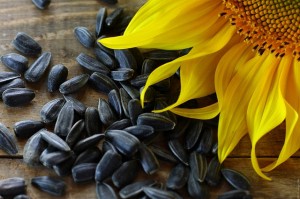
when they got started in Santa Fe
His daughter runs it now and calls it Peace Seedlings
spent a huge amount of diversity he could find in sunflowers
take a bunch of varieties,
it’s the opposite of what were’ trying to make everything in
allen reacted to that mix everything back up and see what’s in there, so he’s done that with sunflowers. If anyone wants to follow your footsteps and grow sunflowers you can get a genetic start with his mix and what you do over the years, save the seeds from the diversity from the ones that you like best and that work best in your yard! You will be starting a trial to short cut this journey back to
I also recommend you go to Bill’s Page there’s a great slide show that really shows what modern ag looks like and where we want to go!
One of the things I wanted to say, if you’re thinking about saving seeds, say you’re a gardener.
Gardening is the number one hobby in America, right along with feeding birds
outdoor hobbies
millions of gardens
virtually none of them save their own seeds
if you want to start
probably have not done it because of what you have been taught, the myths, I call them.
One is it’s too difficult.
It takes too much time and energy
These companies know what they doing and I can buy these super seeds?
spend the 2-3$
look at the ball
why would I do that myself?
why wouldn’t I just buy them?
those are myths, what I’ve learned, I guess I just want as a shout out to all your gardeners.
friend of mine, once said.
we’ve all been “wash-brained!”
Carol Depe said it best, she taught at Harvard she’s a geneticist
home gardener back in Oregon until these last generations. Was from amature breeders
All the food that we eat…came from wild plants…
it’s improved theses things so we have these more easy, nutritious, energy giving plants for us to eat. That all took place before anybody even heard the words like mendel or genetics or uniformity and these terms thrown around by modern seed companies.
everyone of you sitting out there who never saved seeds before
Do it! We’ve always done it!
that’s how we got the diversity
if you’re afraid f making a mistake get over it! Modern ag is the result of making mistakes! We have a lot of great stories we tell in our seed schools
The best selling, most popular winter squash?
That yellow spaghetti squash?
It’s butternut Waltham butternut. You can’t go anywhere, without seeing it.
Waltham wasn’t produced by a modern seed
hasn’t been genetically
hasn’t been patented
anyone can save their own seeds from, that was discovered by mistake in a backyard
If he had been a genetic modern seed saver. He would never allowed the squash to cross pollinate accidentally with something else. He didn’t know what he was doing, something flew in he still doesn’t know what it was
result was a mistake
largest selling winter squash.
so many of our modern food crops if you’re afraid your gonna make a mistake and think it’s complicated and you’ve got to buy a $30 seed saving book, you’ve been misled, just start without knowing what you are doing stay in the game pay attention
join the club!!! Thats how we got modern agriculture ! That’s what we need now! It’s the most important thing you can do!
Can you tell us the basics. Part of the reason Mike’s really the organic gardener is because I don’t really get out there as much? So will you tell us the basics? Let’s pick something and start with step one and save how do you save that seed.
Let’s talk about which ones we should talk about first.
In basic seed saving I divided it into 3 categories. The things that are the easiest, next phase save 2 learn how to do those, and then the last are more complicated expert ones that take a little more attention. Biannuals so you have to pay more attention.
So you always start with the easiest. In my book there are 5 veggies that are really common and popular that also have self-pollinating flowers. It fertilizes itself. Structure is that fertilization starts before flower opens. What that means you don’t have to worry that something is going to fly over the fence, or your neighbors are growing something else or you’re gonna, actually mess things up.
allen
If thats not your goal, keep thing s the way they are, keep it the way you like it.
Start with the self planting
5 every gardener should think about first are:
- tomatoes
- peppers
- peas
- beans
- lettuce.
Wait, beans like green beans or pinto beans?
Both.
People always ask me Bill, how do you save seeds?
complex answer
complex because almost every gamily similarity
genera and species there are difference. So you have to learn your way around a little
different for different things
Let’s talk about the 5 easy ones.
The peas and beans are the easiest because the dried peas and dried beans are the seeds.
growing green beans.
till they’re dried. You’ll get that buckskin color that starts on the pod.
You want to pick them just before they open naturally long after you would pick to eat green beans, sugar snap or green beans. If you’ve in Montana or the west, your season may end, so in that case, just pull the whole plants, let them finish
roots in energy will
finally
let them dry out will they’re brittle I hang them in the garage I put a sheet under them. If they don’t that’s called threshing getting them out of the pods to be chaff
don’t have to clean them much
plant them the next spring.
It can all be a pretty easy system
Peppers are pretty easy, even when they are in an edible stage
just take them Pepper seeds are better and more will germinate if you let them complete their life cycle
to allow the peppers that you picked, the best seeds, or the color they want
let those go, mark them, let them dry out completely
open them up to get that really golden pepper seeds color
So that’s 3/5.
Let’s talk about lettuce next because it’s another dry method, you’re just getting dry seeds off the plate,
experience
walk out into that garden in July and August
comes up in cold soil. loves the cooler weather, but then it starts to get hot and boom! IT bolts or goes to seed. and then it gets bitter, and we stop eating it! This is where we are going to have a change in consciousness! In the past I run out to garden in July and think awww my lettuce my bolted but now I think alright lettuce seeds! looking forward to next cycle
grows up to plant
2-4 feet tall, it has beautiful yellow flowers its nine the
has little sunflowers
like a dandelion little puffs, parachutes
when you get about half or two thirds of flowers looking like dandelion puffs, take that thing and shake it into a bag, if you don’t want to do anything you can let it blow all over the garden will self start in garden next year. A lot of us are seed savers and don’t even know it, that’s a great way.
volunteers come up, select plants
knowing it.
again if your season is shot
plant up before it freezes
pull them all at half gone to seed, and laid them out on tarps and let those full
finish up
fall on the tarps
not falls on the ground
dirty
formed in little ten packs
having a hard time getting them broke up into Just plant that?
10 pack then you think when they first come up
a little chap in there is compost. We don’t have to bring this up to industrial standards
think it has to be uniform
germ tested for industrial ag
When your’e doing it in your own backyard, should be fun passionate filled with mistakes because that’s even more fun!
That leaves tomatoes! The gateway drug to all gardening. 80% of all American gardeners plant tomatoes!
wet method
hold the tomatoes
it was the planet earth place that you picked is the north pole and the bottom is the south pole and then the middle where you cut it open at the equator cavities
in a jelly
keeps them from germinating
When I’m harvesting tomatoes seeds I try to harvest several, I get enough goop it my jar’s about half full, if its not half full, put a little water in there. I’ve been at been at dinner, where I liked it so much. If you do it gently you can still eat the tomatoes.
cut it in half when I got home saved the seeds out.
not giving anything up.
last a home gardener to last the rest of your life
little jar with goop, your tomatoes goop. near your sink, somewhere out of the sun, a white fungus will from on the top it’s bread mold
stir it up after 3 days when that happens
all the good seeds it will fall to the bottom of the jar.What happens is the yeast eats all the jelly way.
separate those tow layers more just fill the jar up, and let the good seeds settle to the bottom and pour all the bad stuff out. Make sure you don’t
Put it in a strainer?
I’m water winning
good seeds will float tot he bottom, as soon as those seeds are settled to the bottom
pour out the water by pouring out the water I’m pirouetting out all the lighter stuff
sees start to put
then I fill the jar back up with water, and I repeat the process
the last time pour it thorough the strainer and I’m left with clean seeds, then I take the strainer flip it onto a paper towel, newspaper paper plate or something and I’ll have a tomato cookie
all be wet
use your and to free them up from each other and you’ll have your tomatoes seeds.
always label their paper plate so you know which ones and make sure you put the year, so I know what year, because I have some saving for years now.
they will keep for year.
WE got 90% germination on tomato seeds that we’re ten years old! Another place we’ve been wash brained! They are way more resilient then most people give them credit! You do not have to buy your seeds anymore if you do you are starting over.
adapting things to
unleashing to adapting to where it is. So let’s not do that anymore people. Start with those 5 things. let’s get this going in our own backyards.
so many seeds you’ll have more then you need and then you share them! That’s really the problem most people have they don’t know what to do with them all!
that’s why seed libraries and seed exchanges are becoming so important
500 seed libraries in the last 3 years!
400 in the US.
Can’t go to a city in Canada without going to a seed Saturday
need new seeds, they don’t start over or buy their seeds from 1000s of miles away. They actually go to a seed exchange get form somebody else in their area and then get them from someone already saving and adapting things piggy back
I didn’t even know what a seed library was till Robin came on last March and that was the first I ever heard about it, so I’m sure listeners are probably new to that idea. So as the inexperienced gardener, I can’t help but think other people are probably thinking the same things, now my husband can grow a pepper or a tomato plant from seed. But if it were me, I would go to the store and buy starts. So for people who are maybe a little apprehensive about trying to growing some of those what I would term harder vegetables that maybe they’ve never grown from seed before cause to me, letting things go to seed is more likely to happen to me because it didn’t get harvested in time, but I’m not as nervous about those things, but I’m on the flip side and might be more nervous about putting a seed in the ground and getting a pepper plant. I always look at Mike and think how do you do that? I know one of his tips is he sprays things with a mister when they are young in the beginning an germinates things in the beginning with a spray bottle. How about us who are intimidated by plant starts?
If it’s really a problem, find somebody locally who’s doing seeds that are adapted to your region, local seeds. A friend of ours, here in AZ , Kim Costion has a CSA for starts. Once a month she delivers all the starts her gardeners’ will need for what’s in season.
Uses seeds
gone down to her local seed and checked out! So that’s one way how to get back into it!
Do you want to tell everyone what a seed library is?
seed library are like they are america’s own reaction to the huge centralization of the seed industry. I think now we have like 3 companies that own 72% of the seeds
So whenever hat happens Americans react! Actually people are all reacting. all over the world that are doing this
1000 year old idea
indian physicist Vandana Shiva
heriloom seed moverment
1000 year tradition if a farmer needs seeds you give them to them! And if and when the can they return 2xs as much! That’s their tradition.
Anybody that knows that’s been involved with seeds. It’s like 1/40th to 1/400th you have to return. Its’ such an abundant process! To return 2xs as much is nothing! Maybe 1/4 of the seeds in one tomato! and if you check out seeds out of a library and so that’s how seed libraries work.
A seed library is where you could go in and look in a card catalog
directors at native seed search at
on the envelope the variety of what it is, and also a story about where it came from where it was grown, in your neighborhood and region and you could check out as many seeds as you wanted. If and when you could you would learn how to save some. And
check in 2xs as much
some of the seed library have seeds checked in by
It’s a beautiful way keep this momentum going
locally a way to strengthen your own
in a way that is not market based
I did make a note, do you want to touch on legality? I have a hard time wrapping my head about it, people are probably wondering what do you mean you can’t save a seed? We watched this movie GMO-OMG! And farmers getting suited over seeds?
If you think it’s an outrageous idea, that somebody could own a plant, and prevent you what you wanted to do with it you are not alone?! Almost all of humanity has thought that.
The first plant patenting legislation, we teach this in our seed schools we have a 6 day program. We have an online version.
Plug away they want to know! This is what listeners are wanting to know!
WE go into the history how we got here. Why we are all doing this and how. teaching you how
seed school
We’ve graduated 700 students from all over the world through our programs, we’ve taken feedback. It’s a 7 week program they are recorded so you don’t have to be there but you can if you want to ask questions.
Everybody knew that. It’s part of the public domain. During the Nixon Admiin to pass the
to patent plants for the first time, but it made some incredible exclusions, farmers could still save and use their own seeds and multiply them and they just couldn’t sell them, you just had to pay a royalty, legislation can get utility patents, that’s where you hear the stories about the large companies suing farmers they have a genetic material on their farm snd idd not buy
buy those, that it actually blew in from drift, some court decided that it still doesn’t matter that they are still in possession of someone else property. I don’t think that the legal ending legal precedents have been set around this year and that there is more to go in the court and that in the end they will give farmers as much credence that is just as old as contract law laws and that allow you to protect yourself and your property and someone causes damage you are allowe dot have redress. Contract law is what these large seed companies are using
we have a contract that they are not going to use these in an improper manner and they are suing them around their contracts. So far they have ruled around contracts but not the other. There haven’t been clean cases
caught up in this seed justice movement
things changed mourned these sorts of issues
I put all my energy in teaching people in saving their seeds, if everyone would take part, millions of Americans consciousness around these laws would quickly change
If you really want to go about changing things, before you go for to fight the worlds largest corporations, let’s make sure we have our own food systems first.
french anarchists
before you go throw rocks at people who provide your own food maybe you should provide your own first. So that’s what I’m really passionate about. What’s great about seed school network of people studying this
14 students start their own seed companies, start their own school
Robin came to school twice
members to help
when I got started go back to mine, I’m in college, UMT 1976 we discover we have enough varieties to start our own seed company, we had not heard of seed libraries then, only way to get their
There was nobody to teach us how to do it.
25 years of making mistakes now to organize people to teach them about it
5 years ago I realized I was the guy I was looking for. 35-40 years of making mistakes, the last I can do is now that I’m in my 60s pass on everything I’ve learned quickly
seed school was born and I’m proud to say we’ve had 100s and 100s of students around the world. And actually this past spring we had our first sed school teacher training
19 teachers become teachers so they could have there own seed schools and train for us. We’re gonna do another in Los Angeles in March 14th -18th nice combination
core of the curriculum hands on twice a day you’ll be presenting perfecting your techniques how to communicate all this info in an effective manner, plus you’ll be a network of other people.
Did I see something else you’re presenting in Oregon, at ?
The Organic Seed Conference
probably the largest gathering of organic seed growers. These guys aren’t necessary seed savers a lot are interested in breeding their own seeds
organic food moment is now a $35 billion dollar industry
org sed alliance who have done unbelievably incredible work around education tobecome better seed breeders
feb 4-6th I’m gonna be on a couple of panels.
one is how to bring education into your seed operation as another profit
Robin is interested in that, it’s hard to have little seed operations. We’re gonna teach about experiences we’ve had on how to do that.
On a panel with talk to the elders, people have been around, it’s hard to believe that make you an elder. 35 years have been around
some of these guys around that will save people steps.
with
seed education panel with my wife bell does the mechanics
Great workshop on how to do
share that workshop sierra seed coop in californai who does her own
5-6 day program
And don Tipping from Williams, OR another fantastic 5 day seed teaching program
one other thing we have a Grain school at Jan 15-17th at the University of Colorado, Colorado Springs, 3 day event where we’re trying to bring people together to talk about ancient grains and the new grains and to grow
how to brew and grind and
to help kick start that part of the local food and movement.
I might be able to get my husband to go to that. Do you know Bob Quinn who has the Kamut Ancient grain in Big Sandy.
That’s a great example of how going out and finding older varieties that are adapted to our climates.
more nutritious whoever bread kamut was superior this has to be done in a laboratory what example of how we can take advantage of what humans have always done best. bring them back to our local c
find
instead of growing hard wheat.
world commodity sell something that nobody else is selling that works for you in your region
Hav you read that book lentil Undergaournd. I just got it out of the library she’s just a great story teller. My interview with Bob Quinn was one of my favorites he’s such a visionary. And growing it in Italy.
grain have
so fast
farmers in AZ grow durham wheat that’s used for pasta and shipped to italy and then shipped back here, the Farmers in AZ are barely making it some years
shipped all the way to Italy, wow how long is that gonna last that kind of fossil fuel based
growing a white Sonoran white wheat which is a 400 year old wheat that was brought from missionaries adapted to the climate
to create a flour tortilla
local food invented in the southwest with a local wheat that invented it and there is only one or two growers, one of them came to our seed school and got the idea there. We went form a few handfuls, to 1100 acres grown last year.
There’s that Quinn model. stared with 48 kernels of kamut, now there are literally a million acres being grown, it’s a phenomenal.
He really wants to grow wheat, our things been water. Last year he planted some,
His goal is to grind our own wheat and he loves to bake our own bread.
just before 30,000 varieties of wheat growing. Go wide and there’s another interesting
Student Jacob Cowgill who for a while worked for Bob Quinn who has started a seed coop in Western Montana 5 valleys seeds. he has does some systematic trials on a wide variety of grains
grow as many different
as you can find
what works for you where you are, that way you can bring out this diversity and hit a home run! And as Jacob said what worked surprised him,
It’s such a great period to be a start of and be a part of this work!
Have fun be passionate make as many mistakes as you can
if you make a living off of what you grow if you are market farmer, you need uniformity and to be able to predict, you need seed that has been grown with more complications and education behind us so there’s always a need for us all to get better
don’t make that mistake and think you need to be pure and scientific to save seeds to be a home gardener and home gardeners making these mistakes is how we got diversity
most important part of foundation
feel empowered
having seeds. start down that path to make yourself a better seed saver. And then once you get tot the point you really want to figure it out you can buy those more expensive
need seed Feb 9th, at SeedSave.org you can get a link to Seed School to sign up for that.
people all over the world great way to use technology you don’t have to go anywhere this winter
great for me, to have someone that wants to listen.
I think I’m about 400-500 listeners. That seems like the minimum and some of the popular ones’ have been downloaded 1000 a show. So you’re speaking to a lot of people. THANK YOU!! What you’re doing is super important and thanks for all you do!
sing up for our newsletter. Become a member
make the rocky mountain seeds
The intro is from Amy Martin’s song It’s about Oil…
The Organic Gardener Podcast is a participant in the Amazon Services LLC Associates Program, an affiliate advertising program designed to provide a means for sites to earn advertising fees by advertising and linking to amazon.com
If you like what you heard on the Organic Gardener Podcast we’d love it if you’d give us review and hopefully a 5 star rating on iTunes so other gardeners can find us and listen to. Just click on the link here:

If you have any comments, questions, guests you’d like to see, or topics you’d like us to cover please send us any feedback positive or negative. We’re here to serve our audience and we can only improve with your help!!! Thanks for visiting Mike’s Green Garden changing the world one garden at a time.

